
 The South African
The South African
Military History Society
Die Suid-Afrikaanse Krygshistoriese Vereniging
Military History Journal
Vol 11 No 5 - June 2000
The war experiences of Mike du Toit:
Eleven days in the Anglo-Boer War
by Pierre du Toit
Grandson
Introduction
Mechiel (Mike) Siewert Wiid du Toit was born in Hopetown,
Cape Colony, in 1868, the only son of the DRC churchwarden.
His father, a stern, uncompromising man, ran a school in
the mission grounds where Mike and his five sisters were
raised in the strict Calvinistic style of the time.
They were sent to the Huguenot Seminary in Wellington
for further education and Mike seems to have attended
SACS as well. After his father's death, he emigrated to the
Transvaal where he worked in the Surveyor-General's office.
Citizenship was bestowed upon him in l892. He was called
up during the jameson Raid (1895/6) and seems to have
enjoyed the military. In 1897 he married Kate Ferguson,
daughter of an American missionary teacher at the
Huguenot Seminary and joined the Staatsartillerie of the
Zuid Afrikaansche Republiek (ZAR)
This is the story of the part that Mike du Toit played
in the armed forces of the ZAR doting the AngloBoer War,
pieced together by his grandson, Pierre, following many
years of research. It was a very short war for Mike, whose
service lasted precisely eleven days. The author had long
suspected that his grandfather had kept a diary and
fruitlessly scoured archives and military museums for it.
After the closure in 1994 of the Fort Klapperkop Museum
outside Pretoria, a Disposal Board was convened and the
diasy, which had been in the museum's possession all along
(despite enquiries by the author), ended up with the Rand
Light Infantry in Johannesburg. Thanks to Sergeant-Major
Peter Wells, the author was able to obtain a copy of the
diary which forms the basis of this article. The author
assumes that the diary was written in English for the
benefit of his grandmother who, although fluent in Dutch,
spoke English at home.
The war experiences of Mike du Toit
Following the Jameson Raid in 1895/6, the ZAR
Government began to take seriously the threat of British
imperialism and the personnel of the Staatsartillerie was
increased from 154 officers and men to 416 within months
after the capture of Jameson. This figure continued to rise
until the outbreak of war. State spending on defence, which
had been a mere £ 87 000 in 1895, leapt to £ 614 000 in
1897 and large quantities of weapons were imported from
Germany and France.
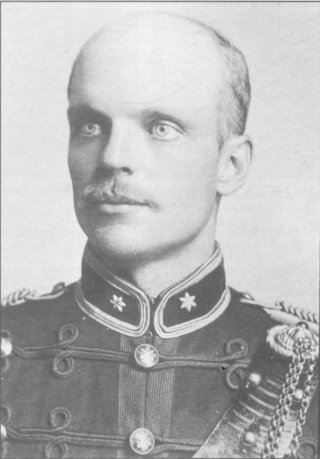
Mechiel (Mike) du Toit, ZAR Staatsartillerie
(Photo: National Cultural History Museum, NFI)
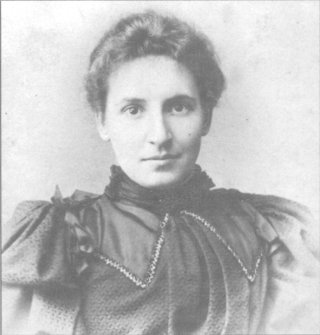
Katie du Toit (neé Ferguson, daughter of an American
missionary teacher at the Huguenot Seminary
(Photo: P du Toit)
Mike du Toit was accepted as a second lieutenant in the
ZAR Staatsartillerie after responding to an advertisement in
the Staatscourant and passing the examination. Subjects
required were Dutch, South African History, Geography,
Algebra, Geometry, Accounting, Nature Study and Artillery
Science. With his new bride, Katie, he moved into a house
in what is today known as Artillery Way, alongside the
headquarters building. He was assigned to the 'Franse'
(French) Battery, the third of the three batteries of the
Staatsartillerie and so called because it was equipped with six
75 mm breech-loading guns from the Schneider works in Le
Creusot, France. This weapon was very effective and
extremely difficult for the enemy to locate, as the low profile
and the use of smokeless powder made it almost invisible.
The main problem experienced with the gun was its brake,
which was insufficient and could not control the kick. The
other batteries were armed with 75 mm Krupp quick-firing
field gulls, the 55 mm siege guns known as 'Long Toms',
37 mm Maxim Nordenfeldt 'pom-poms' and various other
assorted weapons. Discipline in the Staatsartillerie was
similar to that of the Prussian Army, where a number of the
Boer officers had attended courses, and European instructors
had been seconded to mould the force into an efficient
fighting unit. Daily drill and inspection parades were
carried out and the garrisoning of the recently completed
Fort Schanskop formed part of their duties. In 1897, Mike
was promoted to full lieutenant with a salary of £ 275 per
annum. During the same year the battery appears to have
participated in manoeuvres near Rustenburg. Wives and
girlfriends were allowed to visit and during this time a
happy picnic was held in the area.
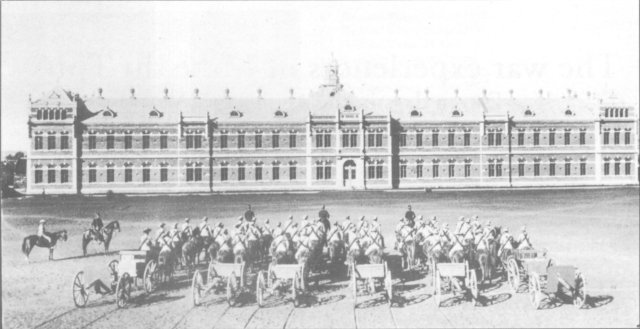
The 3rd Battery, ZAR Staatsartillerie, at Artillery Headquarters, Pretoria
(Photo: National Cultural History Museum, NFI)
In July 1898, the 3rd Battery of the Staatsartillerie
was sent to Swaziland to support thc police who were
attempting to arrest the Swazi king, Bunu. This followed
the murder of a senior induna in the royal kraal in April.
The special commissioner, Krogh, had received instructions
that Bunu must face trial and a summons had been duly
issued but ignored. A week later, Bunu had arrived at the
courthouse with his impis in full battle regalia,
whistling, rattling their spears and singing war songs. When
information reached Pretoria that the whole of Swaziland,
with the support of Dinizulu, was mobilising, Piet Joubert
was dispatched with 1 300 commandos and artillery to
Bremersdorp to restore order. Bunu still refused to hand
himself over and a further 700 men were sent to reinforce
the garrison. The Staatsartillerie constructed a fort on an
exposed rise across the Mzimnene River to the east of the
town. The guns were positioned on platforms 2,4 metres
high, providing a 360 degree field of fire, and surrounded
by a 1,5 metre high earth and sandbag breastwork enclosed
by a trench which was 1,2 metres deep and 1,8 metres wide.
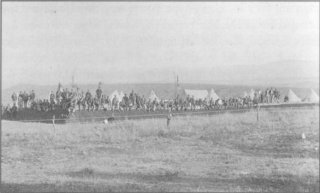
The fort at Bremersdorp (Manzini) during the 1898 Swaziland Expedition
(Photo: National Cultural History Museum, NFI)
In a letter to Katie, Mike wrote:
'I had the honour of shaking hands with her dusky
Majesty the Queen - she is a very fine looking
woman with the smell of a pole-cat about her. I wish
you could see how her court ladies do up their hair.
I shall try to get a collection of photos of native
studies and forward them on to you. Some of the
kraal ladies are as nude as my hand with the most
perfect figures imaginable.'
The letter also contains a sketch of the fort and shows the
lack of security that prevailed.
As with most military operations, boredom was the main
enemy during the campaign and Mike described it as one
of his biggest problems. Bunu fled to Natal and, after much
negotiating between the British and Boer governments,
stood trial in September. He was found not guilty of
murder but guilty of inciting public violence and fined
£ 500 with expenses of £ 1 000 to be paid to the Transvaal
and £ 146 to Natal.
Back in Pretoria, the Staatsartillerie began publication of
their own monthly paper Voorwaarts!, Maandblad van het
Corps Staatsartillerie, with Mike as the editor and Katie, an
accomplished artist, providing the artwork. A banner for the
paper, depicting a cherub, with sword in hand, riding a
shell propelled by another cherub, is dated March 1899. All
eight pages are hand-written. Articles range from the battle
of Laings Nek, a facsimile of Dingaan's land grant to Retief
(in English) and even a correspondence section where a
gunner seeks advice on whether life insurance is Biblically
acceptable. The language used in the paper is generally
Dutch, but occasionally this changes into Afrikaans and it
is interesting to note the development of the language.
Another of Katie's sketches of the time survives. With the
title 'Alarm', it illustrates the falling in of the gunners on
parade. Written across the bottom of this sketch in an
extremely crude hand are the words 'Staats Artillerie Kamp'.
How this scrawl got onto the picture remains a mystery.
The names of various officers appears on the back.
Voorwaarts did not survive long and was soon swallowed
up by other activities as the Corps prepared for the coming
struggle.
In September Mike wrote a letter, in English, to his
sister:
'Art. Camp
Thursday 28th
My dearest sister,
As we are leaving for the frontier tonight I
thought a few lines from me would be welcome.
Ours and the 1st Battery (12 guns) are going to the
Natal border where we expect the heaviest fighting
will be, maar my zuster, ons moed is goed, want onz
zaak is rechtvaardig. I will try to write you now &
again from the seat of war. I returned from Natal
Tuesday & was very thankful to escape with a whole
skin. Give my fondest love to all our dear ones &
with very much love to you and Piet, & don't you
get low spirited Hester. Remember that one Boer is
equal to 10 Englishmen.
Your loving brother
Mike'
His wife also wrote to the same sister:
'Mike has been down to Natal as a spy, he left on
Friday and got back on Tuesday, it was very
dangerous work, but he did it splendidly. They have
been trying to find out one particular thing, and had
sent nine different men already without any success,
& Mike got the information for them.'
Quite what the spying trip entailed is unknown but it is
interesting to note the following undated entry in his diary:
| '18 Hussars |
550 |
| 5 Lancers |
550 |
| 13 RA |
180 |
| 42 |
+/-190 |
| 67 |
+/-190 |
| Leic |
916 |
| Dub Fus |
904 |
| Royal Irish |
1 100 |
| Mount Inf Lec |
300 |
| Indians |
300 |
| |
5 180 |
A fairly accurate assessment of the British force at Dundee!
In early September, it was reported that the British
cabinet had decided to send a further 8 000 troops to
reinforce Natal. President Kruger of the ZAR became
convinced that war was imminent. He needed the Free State
burghers as allies, but President Steyn remained uncertain,
feeling that a peacefnl solution was still possible. Smuts was
instructed to draw up plans for a military offensive and his
plan was for a Blitzkrieg-type thrust deep into Natal
and the occupation of Durban before the arrival of reinforcements
from Britain. On 28 September 1899, President Kruger
decided that he could wait no longer and ordered mobilisation
and the drafting of an ultimatum for presentation to the
British government. President Steyn continued
to hold back, asking for the ultimatum to be redrafted.
Kruger would not be moved on this and on 2 October the
Free State mobilised. The ultimatum was finally presented
to the British agent at 17.00 on 9 October, the same day
that British troops began disembarking in Durban. Smuts's
planned blitzkrieg had lost its advantage.
At the artillery camp, action was feverish on 28 September
1899. Captain Pretorius, in charge of the 3rd Battery,
had his men up before dawn. They paraded and then
marched past the President's house and up Market Street to
the station. Here the scene was festive, the artillery band
under Lieutenant Maggs played stirring music, women wore
their best clothes and hundreds of guests and well wishers
came to see the departure of the contingent. Loading
commenced and sixty men, six guns, eight ammunition
wagons and 105 horses were entrained. Mike kissed his by
then pregnant wife goodbye and then, to the strains of the
Volkslied and the applause of the bystanders, the train
pulled out. After a journey of three monotonous days,
interspersed with interminable halts, the train finally pulled
up at Sandspruit, a siding about 15 km from the Natal
border. As far as the eye could see, the veld was speckled
with tents and wagon laagers as new burghers arrived in a
continuous stream. The horses and equipment were off-loaded
and a camp was pitched. The 3rd Battery had a very
capable veterinary officer (paardenarts) in the person of
Arnold Theiler, who would later gain world renown as the
founder of Onderstepoort. The republican flag and a large
marquee on the left of the tracks announced the presence of
the commandant-general, Piet Joubert, and councils of war
were already in progress.
For the next few days a holiday atmosphere prevailed,
hunting parties went out and braaivleis and Boeremusiek
were the order of the day.
An entry in Mike du Toit's diary for 10 October
describes the scene:
'President's birthday - about 1 200 mounted
men of the Heidelberg Commando paraded and
drew up in front of the General's tent where he
addressed them. Our band then struck the Volkslied
& 3 roaring cheers were given for the Pres. & Genl
Maggs then struck up a spirited march & amidst
cheers the Heidelbergers departed. It is marvellous
how light spirited everyone is, in spite of all the
hardships. We had a very severe hailstorm this
morning & a boisterous gale blew all day I expect
tonight will be bitterly cold.'
The war council was already experiencing the disagreement
that was to plague the Boer forces throughout the
war. Every general wanted his own artillery detachment and
the Staatsartillerie ceased to exist as a cohesive unit as
guns and men were allotted piecemeal to the various commanders.
Mike and others of the 1st and 3rd batteries were attached
to the 2 000-strong commando of General Lukas Meyer.
General Joubert addressed the men from the saddle.
Pointing at Majuba, which was clearly visible from the
camp, and to Natal beyond, he reminded them how that
country had been stolen from their forefathers by the
English and of the victory they had achieved on the
mountain in 1881. He urged them to take it back.
The Boers' plan of attack was to isolate the British
garrisons in central Natal and then to press on to Durban.
The Transvaal forces were divided into three columns: The
left and centre were to attack General Penn Symons at
Dundee whilst the right was to link up with the Freestaters
and attack General White at Ladysmith.
An entry in Mike du Toit's diary for 11 October reads:
'We got orders to pack up everything this morning
so as to be ready to start at 1 o'clock. We got away at
2 & after going about 1 mile [1,6 km] the order
came to outspan. The major & Capt P have gone to
the generals to hear about England's reply to the
ultimatum, the time of which expires at 5 pm. I
expect them back at about 6, & we shall then
probably know if there is to be war or not. The wind
is bitterly cold and I expect we shall have a freezing
night and without tents too for everything is packed
away.'
General White, the British commander in Natal, who had
arrived from India on 7 October, was never in favour of the
positions adopted by General Penn Symons, dividing his
force between the two towns. He wished to consolidate his
force behind the Thukela and await the arrival of Bullet, the
commander-in-chief, and his reinforcements then on the
high seas. The Natal Governor, much influenced by the
debunked Randlords who had sought refuge in Pietermaritzburg,
placed White under immense pressure to save
the coal fields and advised that any withdrawal would be
construed by the still rumbling Zulu impis as a sign of
weakness. White decided to leave the troops where they
were.
On the morning of 12 October 1899, the great advance
began. The right hand column, under the command of the
64 year old General Kock had special orders to cut the
railway line between Dundee and Ladysmith and occupy
the Biggarsberg Pass. The centre, comprising the Heidelberg,
Pretoria and Boksburg commandos under General 'Maroela'
Erasmus, were to take Newcastle and then to attack the
garrison at Dundee from the north-west. The left column
under General Lukas Meyer was to follow the Natal border
to De Jagersdrift and then to cross into Natal and attack
the garrison at Dundee from the north-east. Strategically,
the plan was excellent and should isolate the two
garrisons.
On 12 October, Mike wrote in his diary:
'At Volksrust. Old England wants to fight so we
are going to oblige her. The wagons & horsemen
have been arriving in one continuous stream for over
three hours & are still pouring in. There must be
over 10 000 men here already. A report is being
spread here that the Free Staters crossed the Natal
border this morning. We expect to go over tomorrow,
the major has just been sent for by the general,
so I expect we will know definitely soon.'
The entry for 15 October reads:
'The last three days have been hard ones for
everyone. We left Volksrust on Thursday afternoon
& after going for about two hours a fearful rainstorm
came on & as our provision wagons were too
overloaded we left them behind to follow slowly. The
rain came down in such torrents that I was
compelled to stop the battery & outspan. Most of
the men sat against the gun wheels all night. Fred
R[othmann] and I managed to get a little sleep on
the sopping ground. The whole of Friday was
showery & by evening every bit of my clothes was
wet. In spite of this, I managed to put in a good
night. Yesterday, the sun came through & we got all
our things dry. One of the provision wagons also
caught up with us, so that everyone was in good
humour again after feeding the inner man. Last
night, we came to this place - it belongs to an uncle
of Fred's, but he is away on commando. This
afternoon, we go on to Doornberg where we have to
wait for further orders from Genl Meyer. Yesterday
we heard about the Mafeking encounter & this
morning we heard that 2 000 troops are coming
down to meet us at the Buffels R[iver] Drift.'
Fred F L Rothmann was an old family friend, who seems
to have 'attached' himself to the artillery unit in order to be
with his colleague. The bad weather bogged everything
down. The guns were pulled through, but with insufficient
ammunition, and the horses, mules and cattle were so
knocked up that they could not go on. The expected
reinforcements were the commandos from Pier Retief and
Ermelo, as well as Schalk Burger's Eastern Transvaal
commandos and the Swaziland Police.
On 17 October, Mike du Toit wrote:
'At Doornberg. Yesterday the major sent me in to
Utrecht to buy goods & from there I wired to
K[athy] & had a good breakfast at a real table. When
I returned the artillery had already left for this place
so I had to put in about 20 miles [32 km] quick
trotting. I had taken cold the day before & now
began to feel the effects of it. Last night, I was utterly
miserable & took to my bed on the ground at 6 pm.
It was a real pleasure to see the kindness of the men
when they saw that I was sick. Lottering was
convinced that the only thing for me was a hot
punch & he managed to make some very drinkable
stuff. I am sure it did me good for I had a good night
and am feeling better this morning. When I woke
this morning Mrs Dr B was lying on the ground
about 10 yds [9,14 metres] off, fast asleep. She had
come on horseback in the night & wanted to join us
but I doubt very much if the major will accept her
services at present. A report has just come in that
heavy canon firing [was] heard Ladysmith way
yesterday, so it is possible that Genl Kock and [the]
Free Staters have tackled that town. We are about 15
miles [24 km] distant from Dundee & are expecting
Genl Meyer here this evening, when I trust he will
let us go in at once for there is a certain amount of
dissatisfaction amongst the burghers at this - to
them - reasonless delay.'
The war was already seven days old and still not a shot
had been fired in anger. The column had advanced some 90
kilometres and the Boers, especially the younger ones, were
growing increasingly disenchanted at the lack of action.
Commandant-General Piet Joubert, with the railway at his
disposal, had only advanced 45 kilometres as far as
Newcastle.
Mike's diary entry for 18 October reads:
'Our ammunition wagons have still not turned
up yet so we are still waiting here (near Doornberg).
From the Kop the English Camp at Dundee is quite
visible. They seem to be about 4 000 strong & we
hear that they are very strong in artillery. Our men
are getting very sick.'
The diary continues:
'18th. Eersteling - near De Jagersdrift. At last the
fortified koppies around Dundee are plainly visible
& we are only 4 miles [6,4 km] distant from the
N[atal] border. It is full moon tonight and I expect
the burghers will send out a strong guard for it is not
impossible that the English might try to surprise us.
Report says that there are a little over 5 000 troops in
Dundee with +/- 30 guns.'
On the evening of 19 October, Meyer's force of about
4 000 men assembled at De Jagersdrift and, following a
stirring sermon by Dominee Anderssen of Vryheid, crossed
the Buffalo River into Natal. Guided by a friendly Natalian,
they made their way in the pouring rain across the veld and,
after a brief engagement with a British picket, arrived at the
back of Talana at 03.30 in the morning. Two Krupp guns
and Mike's Creusot 75 mm gun were labouriously hauled
to the summit. Permission to build breastworks was denied
by Meyer. As dawn broke and a gentle breeze cleared the
mist, the enemy camp became clearly visible in the valley
below.
During the night and with great difficulty, General
Erasmus had managed to get his men to the top of the
1 600 metre high Impati Mountain to the north-west of the
town, but the crown was buried in the clouds. In the British
camp, the troops had paraded as usual at 05.00 and were
told to prepare for infantry training. Movement on Talana
caused an uneasy stir and confusion. Human figures were
easily visible, silhouetted against the dawn sky, but were
they members of the town guard, their own picket, or the
Boers? Meyer viewed the unease in the British camp and
kept glancing at Impati from whence the order to attack
should come. After much prompting from the burghers he
eventually gave the order for the artillery to open fire. As the
first shells crashed amongst the British tents, men were seen
scurrying in all directions and Penn Symons is reported as
having said: 'Damned impudence to start shelling before
breakfast!' On top of the hill, the Boer gunners gave it
everything they had. Much of the ammunition was poor
and the percussion fuses failed to explode in the wet
ground. The British artillery was quick to organise and,
after finding that they were out of range, they galloped
through the town and deployed at a range of 2 000 yards
[1 828 metres]. The hilltop was raked by shrapnel and,
without the protection of breastworks and silhouetted
against the eastern skyline, the Boers were forced to pull
back their guns.
At about this time, Mike du Toit was struck below the
left knee by a piece of shrapnel and the bone was broken in
two places. He fell next to his gun, where his friend, Fred
Rothmann, found him trying to crawl to safety from the
hail of shrapnel.
After the war, Mike described the event:
'As I lay by the canon, half conscious, I became
aware of a long slab of a man with a pipe in his
mouth at my side and he indicated that he was going
to carry me piggyback. He manoeuvred me onto his
back and we set off, shells bursting all around us.
One burst so close that it threw both of us to the
ground. All I could hear was Fred cursing the
English because his pipe went missing when he fell.
After finding it he again managed to struggle me
onto his back and on we went.
Fred Rothmann carried him for a few hundred metres
over the stony ground to safety behind some large boulders,
An ambulance arrived shortly thereafter and the injured
man was taken in a stretcher to a farmhouse at the back of
the hill that had been converted into a field hospital. Here
he was placed in the care of a Dr van der Metwe, whose
initial reaction was to amputate, but decided to defer his
decision. Dr C O Moorhead, a general practitioner from
Middelburg, Transvaal, the son of a British military surgeon
and born in India, described the scene at this field hospital,
today known as Thornley Farm, where he was serving with
the Boers:
'The farmhouse, a solid building with stone walls
and stone offices, presented an extraordinary
appearance. The yard was full of horses standing
patiently with their bridles hanging down and their
saddles glistening in the rain. Boers in every possible
state of mind were crowded about - wounded men
were being helped in by their friends, carried down
in blankets or overcoats from the hill above, where
the rifles still cracked out. Shrapnel whizzed noisily
overhead now and then. All looked angry and
frightened. I stepped into the house. Right opposite
me, crumpled in the passage lay the body of Field
Cornet Joubert of the Middelburgers, a little round
hole in the centre of his four-coloured hatband. In a
room to the right the little German artillery doctor
welcomed us warmly and asked for dressings. On a
large bed lay Lt du Toit, with whom I had ridden a
couple of days previously, his leg shattered by
shrapnel. Beside him lay an artillery private shot
through both lungs. The floor was covered with
wounded, pools of water and blood lay everywhere.
Every room was full of groaning forms. I broke into
the tiny pantry and established myself there and for
an hour and more was busy dressing man after man
as they were brought in. The occasional scream of a
shell over the roof told me the fight was not yet over.
There was at length a moment's breathing space, and
I went outside to try and see what was going on. I
noticed a young British officer with a bandaged
hand, Lt Weldon of the 1st Leicestershire. Presently
I saw him strolling nonchalantly away round the hill.
A stout red-faced commandant ordered the burghers
to bring him back. "Leave your weapons here, he is
unarmed," he added further, a kindly trait at such a
moment. The confusion in the hospital all this time
was indescribable. There were only two stretchers
available and wounded men were constantly coming
in. They were laid on the floor until they lay
touching one another all over the house. They were
all wet and sopping, there were no dry clothes or
bedding available but fortunately the kitchen kept
going all day and always provided something warm.
Lt du Toit told me he and an artillery man named
Schultz had worked a Krupp and a Pom Pom until
they were both struck down at the same time. The
next thing I remember was a clear English voice
asking who was in charge of the hospital and the
voice of Dr van der Merwe modestly replying that he
thought he was. I went out and found a flushed and
panting subaltern of the Dublin Fusiliers, his helmet
pushed back, a sword in one hand and a revolver in
the other. At his back [was] half a company of grimy,
panting soldiers with fixed bayonets. The British had
taken possession, the hill was theirs. Some British
wounded now came in but room was found with the
greatest difficulty, there were over 80 people lying in
one small house. It is interesting to note that the
British fired 1 237 rounds of shell and the troops
82 000 rounds of ball cartridge. Therefore at this
battle it took about 8 oz shrapnel and over 500 Lee
Metford bullets to account for every Transvaaler.'
After a fierce struggle, the British had driven the Boers
off Talana and the burghers were streaming back across the
veld to De Jagersdrift. It was at best a Pyrrhic victory for the
British troops. Totally exhausted, they had been on their
feet without food for ten hours and were in no condition to
pursue the Boers. Their casualty figures were horrendous:
51 dead and dying (including General Penn Symons), 203
wounded and 220 missing. General Yule, who had assumed
command after Symons was mortally wounded, received
reports of large bodies of Boers advancing on the town from
the opposite direction and ordered his men back to camp.
Throughout the battle, General Erasmus, on top of
Impati, had stood impassively, sucking on his pipe,
glowering into the mist. The sound of the battle below
reverberated off the surrounding hills and despite the
pleadings of his men to lead them into battle, he still took
no action. No satisfactory explanation has ever been given
for Erasmus' inactivity and the failure of General Kock to
attack along the railway from Glencoe junction, but it may
well have been the personality clashes that existed. There is
no doubt that, had the three pronged co-ordinated attack
taken place as planned, the British force would have been
annihilated.
On the morning of 21 October the Boers positioned a
155 mm Long Tom siege gun on the slopes of Mount
Impati and began shelling the British camp at a range of
10 000 yards [9 140 metres]. British intelligence had
reported these guns, originally used for the defence of
Pretoria, as immovable and their appearance on the hill
came as a nasty shock to the new British commanding
officer, General Yule. He spent the day moving his men
out of the range of the 80-pound shells, before abandoning
his hospitals and the wounded, and slipping away during
the night. The same day, the Boers from Mount Impati
occupied Dundee.
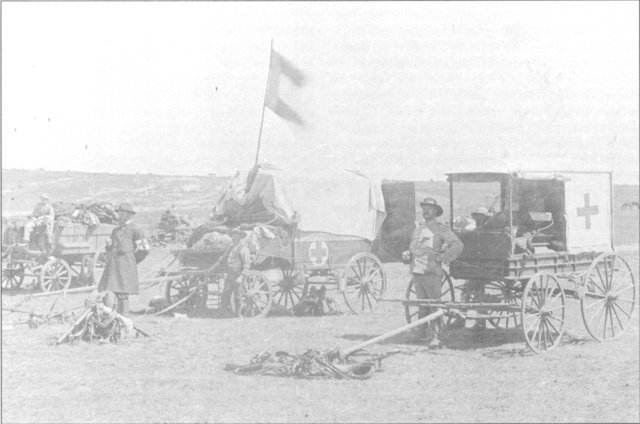
A Boer field ambulance
(Photo: By courtesy, War Museum of the Boer republics, Bloemfontein)
In the Boer hospital behind the hill, Fred Rothmann sat
with Mike throughout the night. The next morning, the
Boer doctors loaded the wounded onto wagons and sent
them to the field ambulance at De Jagersdrift. Fred,
accompanying Mike, described the scene in a letter to his
sister, written in English. These are extracts:
'DeJagersdrif, 25 October 1899
I write from our ambulance station, where our
wounded have been brought following the battle. I
managed to get a room for Mike on his own. It was
very fortunate, because I don't know what we would
have done in a larger room with other people. He is
in continuous pain and I sit with him day and night.
He can only sleep with morphine and this is the only
time I get any sleep. We have plenty of food but
need trained nurses desperately. A British doctor has
come out from Dundee, and after consulting with
our doctors, agreed to take the badly wounded into
the hospital in Dundee. It will be impossible for
Mike to go the fifteen miles by wagon and this
British doctor has kindly offered to have him
transported in a dhoolie.'
Mike composed a telegram to the State Secretary, Reitz,
asking for his sister Leonora, a trained nurse, to be sent to
look after him. He also wired Katie and the telegram was
sent by the ever faithful Fred Rothmann:
'There is a chance of [my] leg being amputated, [I]
am leaving for Dundee tomorrow. See President for
free pass for [your]self and Leo. Come through Natal
to Dundee. Can get cottage for us. Bring water
pillows for bedsores. Fred is with me, bring Annie
[Fred's sister].'
The British doctor referred to in the extract above was
Surgeon-Major F A B Daly, an Australian serving in the
British hospital which had been abandoned by the
retreating General Yule. Daly published his memoirs many
years after the war and recounted the incident. After
consultation with the Boer doctors, Mike was assured that
his leg could be saved, provided he was moved to the
hospital that had been set up in the Scandinavian mission
in Dundee. He did not seem to think that he could survive
the journey and the final entry in his diary was a letter
addressed to Katie in a different handwriting:
'My dear old Katie,
The d[octo]rs think that I should be carried to
Dundee, a distance of 15 miles [24 km] to have the
x-rays tried on my leg. Personally I don't think I can
live through this journey that is why I am dictating
these lines to Fred. Everyone has been most kind to
me. Be sure Katie that if I do die tomorrow my last
thoughts will be of you.
Fondest love
Mike'
Mike du Toit stood the journey well and was housed in
the home of the local minister, together with a number of
wounded British officers. He was of great assistance to Dr
Daly in procuring supplies from the local commandant and
even managed to organise 297 sheep for the hospital. Upon
his return to Pretoria, Mike spoke so highly of Dr Daly that
Louis Botha presented a set of trophy kudu horns to the
doctor.
On 10 November, Mike's condition was so improved
that he was fit to travel and a special train with an
ambulance carriage conveyed him, Katie and Leonora to
Elandslaagte, where they remained for about ten days and
could clearly hear the booming of the artillery as Ladysmith
was besieged. No more wounded were received and the
train was required to move up to Modderspruit, closer to
the front. The doctor thought that Mike should be sent to
hospital in Pretoria and so they were placed in a van and
attached to an ordinary train.
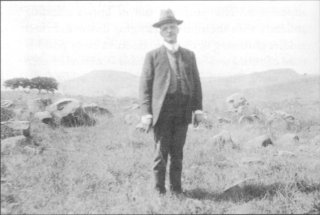
In later years, Mike du Toit (above) revisited the exact site
where he was injured during the Anglo-Boer War.
(Photo: By courtesy of P du Toit)
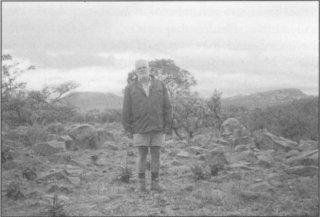
The author recently visited the site where his grandfather was
injured in battle during the Anglo-Boer War.
(Photo: By courtesy of P du Toit)
On 17 November, Izaac von Alphen used his newly
acquired x-ray apparatus to assist doctors von der Horst and
von Gernet in removing a piece of shrapnel and two bullets
from Mike's leg. When the British occupied Pretoria on
6 June 1900, Mike, back in uniform and only able to walk
with difficulty, was taken prisoner. On 26 July, he was
granted parole and, with Katie and their recently born son
Louis, was given permission to proceed to Hopetown to stay
with his brother-in-law, Pieter du Toit. From there, they
moved to Gordons' Bay, where they appear to have been
when the war ended. Mike had to report to the Military
Governor at the Castle twice a month, which entailed a
four-day horse-cart journey across the Cape flats.
The years after the war were difficult until Mike du Toit
met his wartime colleague, J B M Hertzog, and obtained
the post of Police Commissioner in the Orange River
Colony. He remained in police service until 1928 when he
contested and won the Pretoria West seat for the National
Party. He continued in politics until shortly before his
death in 1939.
Bibliography
Amery, L S (ed), The Times History of the War in South Africa, 1899-1902
Breytenbach, J H, Die geskiedenis van die Tweede Vryheidsoorlog in Suid-Afrika.
Daly, F A B, Boer War memoirs.
Die Brandwag, June - October 1910.
Die Volkstem, October - November 1899.
Du Toit, M S W, A 1838, W77, State Archives, Pretoria.
Gutsche, Thelma, There was a man.
Haupt, D J, Die Staatsartillerie van die Suid-Afrikaanse Republiek.
Huisgenoot, 9 October 1925.
Kommando, October 1950, June 1954.
Matsebula, J S M, A history ofSwaziland.
M E R, Oorlogsdagboek van 'n Transvaalse burger te velde, 1900-1901.
M E R, My beskeie deel.
Militaria, 6 February 1976.
Pakenham, T, The Boer War.
Preller, G S, Dr, Talana.
Reitz, D, Commando: A Boer journal of the Anglo-Boer War.
Rothmann, F L, A 1877, A321, State Archives, Pretoria.
Suter, F A, Dr, Unter der Schweizerischen Roten Kreuz im Burenkriege.
Return to Journal Index OR Society's
Home page
South African
Military History Society /
scribe@samilitaryhistory.org


 The South African
The South African





